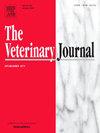哈萨克斯坦牛冠状病毒的发生及流行病学研究
IF 3.1
2区 农林科学
Q1 VETERINARY SCIENCES
引用次数: 0
摘要
牛冠状病毒(BCoV)在牛中引起胃肠道和呼吸道疾病,但其在哈萨克斯坦的流行情况尚不清楚。这项全国性的横断面研究旨在评估牛中BCoV的流行情况并调查其流行病学特征。2024年4月至8月期间,从哈萨克斯坦17个州390个农场的2237头临床健康牛身上收集了血清、鼻和直肠拭子样本。没有农场主报告接种了BCoV疫苗。使用市售ELISA检测血清样本中BCoV特异性抗体,同时对合并鼻和直肠拭子进行巢式RT-PCR检测以检测BCoV RNA。RT-PCR检测后进行测序和系统发育分析。单变量GEE模型用于评估危险因素,多变量模型用于改进发现的关联。动物水平BCoV血清阳性率为88.2% (95% CI: 84.3% ~ 92.0%),而畜群水平血清阳性率为89.6% (95% CI: 85.4% ~ 92.9%)。与其他地区相比,哈萨克斯坦东部地区的血清患病率最低。血清阳性与牛的年龄、性别和品种无关,但与牛在后院的比例、牛密度和农场规模有关。在12个州的取样动物中,有2.4%(95%可信区间:1.4% - 3.4%)和7.8%(95%可信区间:5.3% - 11.0%)的牛场中检测到BCoV脱落。全血凝素/酯酶和刺突基因的系统发育分析表明,哈萨克斯坦BCoV株属于GIIa类群。哈萨克斯坦关于BCoV的第一份报告证实了其地方性存在,强调了制定国家控制规划的必要性。本文章由计算机程序翻译,如有差异,请以英文原文为准。
Occurrence and epidemiology of bovine coronavirus in cattle in Kazakhstan
Bovine coronavirus (BCoV) causes gastrointestinal and respiratory diseases in cattle, but its prevalence in Kazakhstan remains unknown. This nationwide cross-sectional study aimed to assess BCoV prevalence in cattle and to investigate its epidemiological characteristics. Between April and August 2024, serum, nasal and rectal swab samples were collected from 2237 clinically healthy cattle across 390 farms in 17 oblasts of Kazakhstan. None of the farm owners reported vaccinating against BCoV. Serum samples were tested for BCoV-specific antibodies using a commercially available ELISA, while nested RT-PCR assays were performed on pooled nasal and rectal swabs to detect BCoV RNA. Sequencing and phylogenetic analysis were performed following RT-PCR testing. A univariate GEE model was used to assess the risk factors and a multivariate model was employed to refine the discovered associations. The animal-level seroprevalence of BCoV was 88.2 % (95 % CI: 84.3 %–92.0 %), while the herd-level seroprevalence was 89.6 % (95 % CI: 85.4 %–92.9 %). The eastern region of Kazakhstan had the lowest seroprevalence compared to other regions. Seropositivity was not associated with age, sex or breed, but correlated with the proportion of cattle in backyards, cattle density and farm size. BCoV shedding was detected in 2.4 % (95 % CI: 1.4 5 % - 3.4 %) of sampled animals and in 7.8 % (95 %CI: 5.3 % – 11.0 %) of cattle operations across 12 oblasts. Phylogenetic analysis of the complete hemagglutinin/esterase and spike genes revealed that the Kazakhstani BCoV strains belonged to the GIIa group. This first report on BCoV in Kazakhstan confirms its endemic presence, highlighting the need for a national control program.
求助全文
通过发布文献求助,成功后即可免费获取论文全文。
去求助
来源期刊

Veterinary journal
农林科学-兽医学
CiteScore
4.10
自引率
4.50%
发文量
79
审稿时长
40 days
期刊介绍:
The Veterinary Journal (established 1875) publishes worldwide contributions on all aspects of veterinary science and its related subjects. It provides regular book reviews and a short communications section. The journal regularly commissions topical reviews and commentaries on features of major importance. Research areas include infectious diseases, applied biochemistry, parasitology, endocrinology, microbiology, immunology, pathology, pharmacology, physiology, molecular biology, immunogenetics, surgery, ophthalmology, dermatology and oncology.
 求助内容:
求助内容: 应助结果提醒方式:
应助结果提醒方式:


